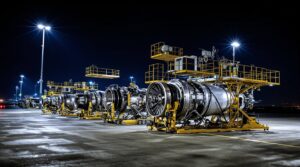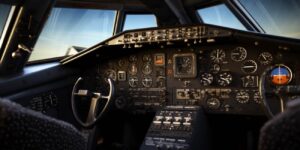The impact of a bird strike is influenced by various factors, including the size and weight of the bird, as well as the speed of the aircraft. Birds can range from small songbirds to larger waterfowl, and the collision can occur during takeoff, landing, or even at cruising altitudes. The consequences of a bird strike in aircraft can range from superficial damage to critical components, such as engines or windshields.
To understand how to avoid bird strikes on aircraft, it’s crucial to delve into the reasons behind these collisions. Birds often share airspace with aircraft, and their movements can be unpredictable. Pilots and aviation authorities employ various strategies and technologies to minimize the risk of bird strikes.
Radar systems play a vital role in detecting bird flocks, allowing air traffic controllers to provide timely warnings to pilots. Additionally, airports implement wildlife management programs to reduce bird populations in the vicinity of runways. These programs may include habitat modification, deterrents, and even the use of trained birds of prey to discourage other birds from congregating in high-risk areas.
Engine manufacturers also contribute to preventing bird strikes by designing engines to withstand impacts. This includes testing engines with bird-sized gelatinous material to simulate a collision and ensure the engine’s durability. Furthermore, aircraft design may incorporate features like bird strike-resistant windshields to minimize damage in the event of a collision.
Understanding the migratory patterns of birds is another essential aspect of avoiding bird strikes on aircraft. Airlines and pilots receive information about bird concentrations along flight paths and adjust routes accordingly. This proactive approach helps reduce the likelihood of encounters between aircraft and large flocks of birds.
Mitigating risks of engine failure due to birds sucked into jet turbines
Engine failure due to birds getting sucked into jet turbines poses a significant risk to aviation safety. The aviation industry continually strives to develop and implement effective measures to mitigate this risk and ensure the safety of passengers and crew.
One crucial aspect of addressing this concern is the design of aircraft engines. Engineers are incorporating advanced technologies and innovative features to create engines that are more resilient to bird strikes. These engines are equipped with reinforced materials and protective structures to minimize the impact of birds entering the turbine.
Moreover, regular inspections and maintenance play a pivotal role in preventing engine failure. Airlines and maintenance crews adhere to strict schedules for checking and cleaning engines, ensuring that any foreign object, especially bird remnants, is detected and removed promptly. This practice is essential in maintaining the optimal performance of the engine and reducing the likelihood of failure.
Bird strike detection systems are another innovative solution to mitigate the risks associated with engine failure. These systems utilize advanced sensors and radars to identify birds in the vicinity of the aircraft. Once detected, the system can trigger alerts for pilots to take evasive actions or adjust the aircraft’s speed and altitude to avoid potential bird strikes.
Additionally, airports and airlines collaborate on wildlife management programs to control the bird population in and around airports. This involves implementing measures such as habitat modification, bird relocation, and even the use of trained falcons to deter birds from approaching aircraft. By reducing the bird population near airports, the chances of birds entering jet turbines are significantly diminished.
While advancements in technology and proactive measures are crucial, pilot training remains a fundamental component in the effort to mitigate the risks of engine failure. Pilots are trained to recognize and respond to bird strikes effectively. This includes following established procedures for emergency situations, such as adjusting flight paths or declaring an emergency landing if necessary.
Collaboration between aviation authorities, aircraft manufacturers, and airlines is essential for creating and implementing comprehensive strategies to address the risks associated with bird strikes. Regular information sharing and updates on best practices ensure that the industry remains proactive in enhancing safety measures.
Necessary aircraft mechanisms minimizing effects of bird hits mid-flight
Modern aviation has evolved to incorporate a myriad of sensors and detection systems aimed at ensuring the safety of flights in various conditions. One critical aspect that these mechanisms address is the potential threat posed by bird strikes mid-flight. In the realm of aviation, minimizing the effects of such encounters is paramount for the well-being of both the aircraft and its occupants.
One of the key sensors installed on aircraft to counteract bird strikes is the bird collision detection system. This advanced technology relies on radar and alarm mechanisms to identify incoming flocks or individual birds. The detection systems utilize sophisticated algorithms to differentiate between normal air traffic and potential bird threats, sending immediate signals to the cockpit when necessary.
Imagine a scenario where a flock of birds is on a collision course with an aircraft. The on-board detection systems, equipped with cutting-edge sensors, swiftly recognize the impending danger. In response, the system triggers a series of alerts to the cockpit, instantly notifying the pilots of the potential hazard. This real-time information is crucial in allowing the flight crew to make swift and informed decisions to avoid or mitigate the impact of the bird strike.
As these detection systems play a pivotal role in bird strike prevention, they are complemented by state-of-the-art alarms designed to capture the attention of the pilots. The alarm signals are strategically placed within the cockpit, ensuring that they are impossible for the flight crew to ignore. These alarms, coupled with visual alerts on the cockpit display, create a multi-sensory experience for the pilots, enhancing their ability to respond swiftly and effectively.
The integration of bird strike prevention mechanisms extends beyond the use of sensors and detection systems to include the design and reinforcement of aircraft structures, especially around vulnerable areas like the engines and cockpit. Cockpit windshields, for instance, are often constructed with reinforced materials to withstand the impact of bird strikes. Such structural enhancements provide an additional layer of protection, reducing the likelihood of damage that could compromise the safety of the flight.
Faa regulations, flight patterns, airport locations, wildlife management
When it comes to aviation, FAA regulations play a crucial role in ensuring the safety and efficiency of air travel. These regulations, set by the Federal Aviation Administration, cover a wide range of aspects, including flight patterns, altitudes, and speeds. Pilots adhere to these guidelines to navigate through the airspace seamlessly.
Understanding flight patterns is essential for both pilots and air traffic controllers. Various factors influence these patterns, such as air traffic density, geographic features, and proximity to airport locations. Airports, as hubs of transportation, are strategically situated, considering factors like weather patterns and the surrounding environment.
Wildlife poses a unique challenge in aviation, and wildlife management is a critical aspect of maintaining safety. Airports implement measures to prevent bird strikes and other wildlife-related incidents. This involves studying local habitats around airports and implementing strategies to mitigate potential risks to aircraft.
Understanding the natural environment is crucial, especially considering migration routes of birds and other wildlife. During certain seasons, these routes may intersect with established flight paths, leading to increased risks. Airlines and aviation authorities carefully consider these factors to minimize the likelihood of collisions and disturbances to natural habitats.
Migration routes are not the only natural phenomena that impact aviation. Seasons bring about changes in weather patterns, affecting everything from turbulence to visibility. Pilots must be aware of how seasons influence altitudes and flight speeds to ensure a smooth journey for passengers and cargo.
Altitudes and speeds are intricately linked to both safety and efficiency. Pilots must adjust their altitudes based on factors like air pressure and turbulence. Similarly, optimizing flight speeds contributes to fuel efficiency and overall sustainability in aviation operations.
In essence, the dynamic interplay between FAA regulations, flight patterns, airport locations, wildlife management, habitats, migration routes, seasons, altitudes, and speeds creates a harmonious balance in the complex world of aviation.






